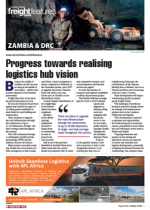In a strategic move to bolster expansion and growth, J&J Transport Africa has deployed its Zambian-registered vehicles along the Walvis Bay Corridor. This initiative enhances the company’s reach and capability providing clients with robust solutions from the landlocked regions of the Democratic Republic of the Congo (DRC) and Zambia. According to Chris van Tonder, group chief operating officer, the route has already shown significant promise, with exciting prospects on the horizon.The company has also invested in state-of-the-art facilities in Lusaka, featuring newly built warehouses and a container terminal.“Implementing our core technologies and sophisticated f leet management systems, we have streamlined border documentation processes, reduced customs clearance delays, introduced cashless transactions and identified bottlenecks within the value chain. We have also increased transparency within our overall operations,” he said. “This has assisted in driving the efficiencies from end to end. Our border offices, which are strategically located at both the entry and exit points of Chirundu, Kazungula, Sakania and Kasumbalesa borders, have been a game changer, providing a visible presence on the ground to assist our f leets in optimising crossing times.”Van Tonder said considering the positive contributions and overall success of these offices, the company had decided to establish additional operational offices in Lubumbashi, Kolwezi, and at various mines in the Kolwezi region to further reduce vehicle turnaround times.When asked about the current market conditions, he described them as strenuous, noting that the past few months had been quite challenging. “We have seen rate levels under significant pressure, as well as an imbalance between inbound and outbound cargo. The demand for capacity is still on the rise from both Zambia and the DRC, although the disparity in bidirectional cargo f lows continues to hamper the availability of outbound capacity from both countries to the various ports.”According to Van Tonder, the recent El Niño effect and weather patterns have had a major impact, significantly affecting agriculture in both countries. “The drought has caused fertiliser movements to stagnate for a certain period, but we have seen an increase in the movement of aid and relief cargo into the region. The fact that Zambia also relies heavily on hydroelectric power has caused serious strain on the overall business environment, putting all sectors across the industry under immense pressure,” he said. “The DRC has also been experiencing similar challenges, affecting productivity at certain mines in the region. Poor road conditions in the network between Zambia and the DRC continue to pose challenges to hauliers operating on the respective routes between the two countries.”With the DRC holding 70% of the world’s cobalt reserves and projections indicating that copper production will have grown by 220% by 2026, the outlook for both the DRC and Zambia remains positive. "Mines will drive productivity levels to increase their output to meet these demands, which is very promising for the transport and logistics industry. The resumption of operations at the Kipushi Mine is particularly promising, as it is the highest-grade zinc mine in the world. We should see significant volumes moving from this mine to various ports," he said. "Additionally, the expansion at Kamoa-Kakula, now becoming the world's third-largest copper mine with the addition of their third concentrator, underscores the DRC's status as a key player in global mineral exports. This development means the DRC has become the Holy Grail for exporting these minerals to global markets."Volumes continue to increase," said Van Tonder. “In addition to the aid and relief cargo, we are also seeing an increase in maize and wheat volumes. Export volumes out of Zambia have also remained stable.”No major disruptions are expected for the rest of 2024. “For Zambia, the outlook is positive. We expect volumes to remain similar to what we have seen to date, with possible increases expected for the rest of the year. Rates could possibly increase in the fourth quarter of the year.”

